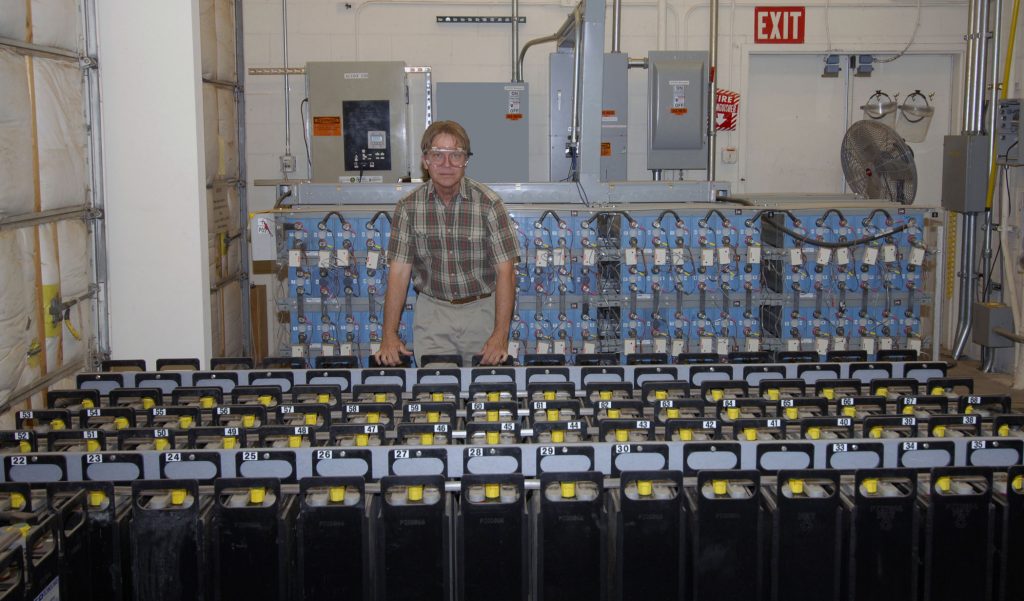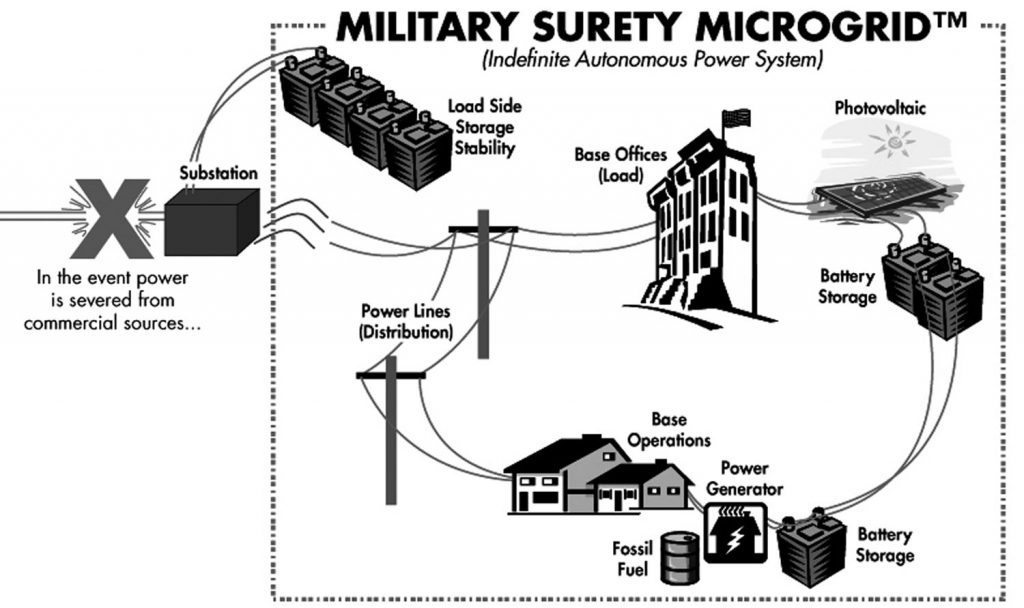
Download 300dpi JPEG image, “microgrid-batteries.jpg,” 488K (Media are welcome to download/publish this image with related news stories.)
ALBUQUERQUE, N.M. — A Sandia National Laboratories research team headed by Dave Menicucci has taken a Labs-developed energy surety model to a tangible level by applying it to military bases.
The team, working with the U.S. Army, is looking at how military bases can improve energy generation and transmission through a new system called the Energy Surety.
“In today’s grid system, power generators [coal, nuclear, gas] are located far from the load — the place where people live, work, and use power,” Menicucci says. “This requires much distributed wiring and has a potential for power disruption.”
What the microgrid team envisions for military bases is an energy surety system that uses more small generation units and storage near the load and less generation at big plants. It can operate with or without the grid. In addition to being smaller, the power generators would integrate a diversified fuel mix, include secure on-site fuel storage and apply sustainable technology, such as renewable energy.
Rush Robinett, senior manager of Sandia’s Energy and Infrastructures Futures Group, says this model is “like back to the future.”
“Military bases used to co-manufacture energy in the same area as is proposed here,” he says. “Now most are totally dependent on the grid for power.”
Funding for the project comes from the U.S. Army and the internal Sandia Laboratory Directed Research and Development (LDRD) program.

Download 300dpi JPEG image, “microgrid-graphic.jpg,” 200K (Media are welcome to download/publish this image with related news stories.)
Sandia is a National Nuclear Security Administration laboratory.
Energy systems with high levels of energy surety must be safe — safely supplying energy to end users; secure — using diversified energy sources; reliable — maintaining power when and where needed; sustainable — being able to be maintained indefinitely (“indefinite” is based on the American Indian definition of seven generations or 200 years); and cost-effective — producing energy at an acceptable (and preferably lowest) cost.
Menicucci says the current grid system meets some of these criteria, while the proposed microgrid system for military bases would meet all.
“The existing [grid] system is generally safe and secure,” Menicucci says. “The generation and storage are reliable. The problem comes from the fact that generators are far away from people and the power has to be transmitted through thousands of miles of lines.”
If any of these lines go down, either through an act of nature or terrorism, power will be disrupted and the country’s national security could be threatened.
Menicucci also asserts that current generation methods are not sustainable.
“It’s not that we are running out of oil and coal, it’s that we can’t predict the cost, implying that we can’t afford it,” he says. “The demand for more fuel from China and India are driving prices up. There are also limits to where we can drill.”

Download 300dpi JPEG image, “photovoltaics.jpg,” 700K (Media are welcome to download/publish this image with related news stories.)
While the cost-effectiveness of the current generation system is OK, Menicucci anticipates it may not stay that way for long.
The Sandia team believes the solution is what they are researching for Army bases across the country — a microgrid that reduces the single points of failure by cutting down the number of transmission lines.
In looking at the five criteria of an energy surety approach, the microgrid meets all. It is safe — it’s not introducing any new dangers. It’s secure because it uses a diverse mix of fuels — solar, wind, and oil. It’s reliable because it uses a variety of types of generators. There is a redundancy of generation and storage. It’s sustainable because it is using renewable energies. And, it is cost-effective because it uses energy sources that are readily available and appropriate for the site. (An example is that solar could be used in the Southwest and wind along the nation’s coastlines.)
Menicucci says there are two reasons Sandia paired with the Army in planning microgrid systems at military bases. Sandia is a national security laboratory and the team members, most of whom have been in the armed forces, understand how the military operates.
The research team is now working with the Army to develop an energy surety microgrid for a soon-to-be selected military base. They are resolving such issues as where to put the smaller generators, how much storage is needed, and microgrid control.
Next spring a test military base will be determined, and a microgrid system will be installed and tested.
“The ultimate goal is to have microgrids at all military bases in the country and eventually in civilian communities,” Menicucci says.